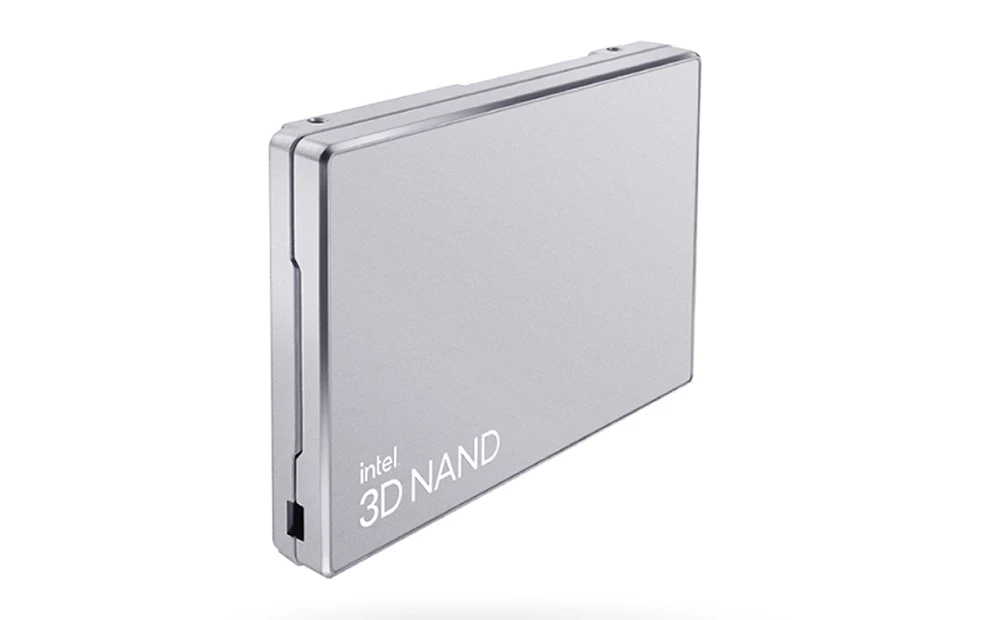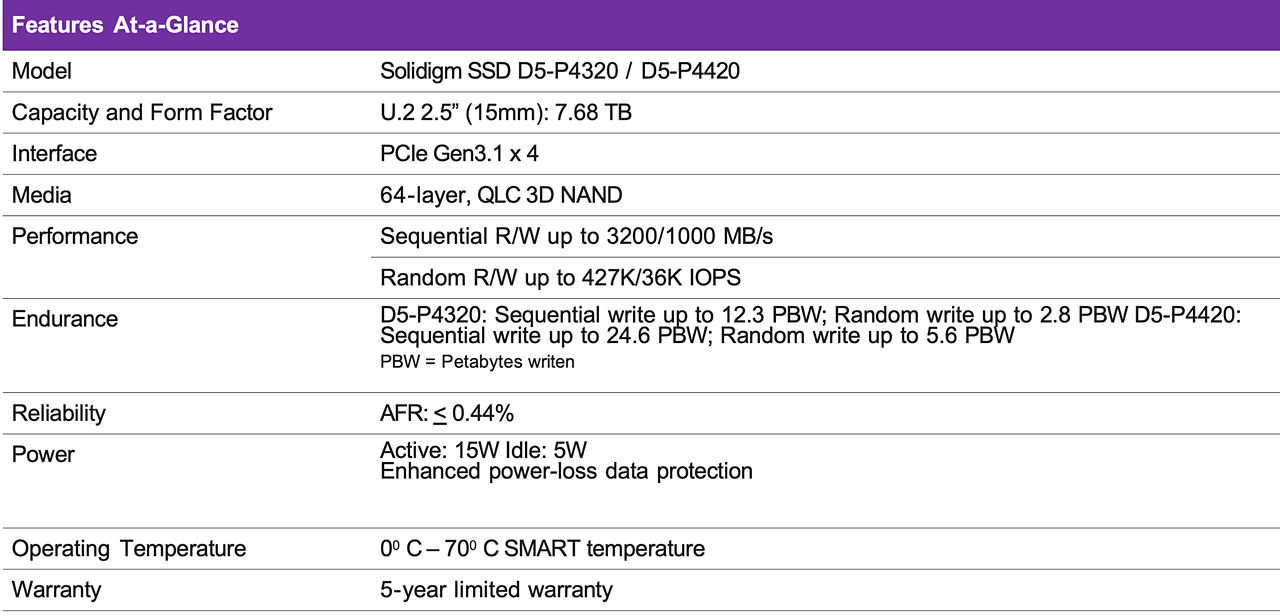Solidigm™ D5-P4320 and D5-P4420 Product Brief
Formerly Intel® SSD D5-P4320 and D5-P4420
Solidigm D5-P4320 and D5-P4420 SSDs deliver big, affordable, and reliable storage to the warm data tier. With 33% more bits per cell than TLC, [2] the Solidigm QLC 3D NAND SSDs enables 3x storage consolidation [3] compared to hard disk drives (HDDs), leading to lower operational costs. As the industry’s first PCIe*-enabled QLC drive for the data center, the D5-P4320 provides the ability to scale to large capacities and deliver the performance needed for storage workload requirements. The D5-P4420 drive offers double the endurance, supporting an even wider range of workloads.

Store more: Big capacities store massive quantities of data
The Solidigm QLC technology offers an aerial density advantage of 33% more bits per cell than the prior generation of Solidigm 3D NAND SSDs. The result? Higher capacity, cost-effective PCIe drives optimized for read-intensive storage workloads. Both the D5-P4320 and D5-P4420 are currently available in a U.2 form factor with 7.68TB capacity.
Save more: High density reduces operational cost
Today’s data center storage often relies on a mix of HDD and SSD technologies. The Solidigm D5-P4320 and D5-P4420 deliver high capacity and lower operational cost for the capacity or “warm” data storage layer traditionally served by hybrid or HDD arrays. With its higher density, Solidigm QLC 3D NAND SSDs mean fewer drives to support, power, and cool. In addition, Solidigm Data Center SSDs have a lower annual failure rate, [4] which further reduces costs.
Do more: PCIe accelerates workloads at large capacities
All QLC-enabled SSDs are not created equal. In addition to massive capacities, the D5-P4320 and D5-P4420 are built on the PCIe* interface, which delivers higher maximum performance than the SATA interface. [5] Both SKUs allow for much denser systems while enabling performance per TB to continue scaling well beyond SATA-based QLC SSDs. The Solidigm QLC SSDs, when combined with Solidigm Synergy™ technology, accelerate the speed of frequently accessed data, at the price and capacity of massive storage.
Backed by Solidigm experience and innovation
Solidigm brings longstanding expertise and leadership in data management to address the capacity and performance issues of today’s data centers. Prepare for the future with PCIe Solidigm QLC SSDs, backed by Solidigm’s technology and manufacturing leadership.

Notes
[1] Based on Solidigm achieving PRQ status of Solidigm SSD D5-P4320 on July 13, 2018
[2] Source: Solidigm. 33% more bits per cell. TLC (tri-level cell) contains 3 bits per cell and QLC (quad level cell) contains 4 bits per cell. Calculated as (4-3)/3 = 33% more bits per cell.
[3] Consolidate storage footprint up to 3x. Based on 4TB 3.5’ HDD - WD Gold TB Enterprise class 7200 RPM SSD configuration based on 7.68TB Solidigm D5-P4320 QLC SSD: 3 2U nodes per 1PB - 1,106TB total using 144 7.68TB D5-P4320 SSDs; 48 2.5” SSDs per 2U node using 2.5” U.2 from factor; 3 2U nodes for 6U total. HDD configuration based on 4TB 3.5’ HDD: - 10 2U nodes per 1PB – 960TB total based on 24 3.5” HDDs per 2U.
[4] Industry AFR Average: Source – https://www.backblaze.com/blog/2018-hard-drive-failure-rates/. Source – Solidigm. Solidigm SSD Annualized Failure Rate Report for 2018 for products shipping >1Mu
[5] Source: Microcontroller Tips, March 29, 2018 - SATA has throughput up to 6GB/s; SAS throughput is up to 12GB/s; PCIe 3.0 throughput is up to 16GB/s. https://www.microcontrollertips.com/why-nvme-ssds-are-faster-than-sata-ssds/
Performance tests, such as SYSmark and MobileMark, are measured using specific computer systems, components, software, operations and functions. Any change to any of those factors may cause the results to vary. You should consult other information and performance tests to assist you in fully evaluating your contemplated purchases, including the performance of that product when combined with other products.
Solidigm technologies’ features and benefits depend on system configuration and may require enabled hardware, software or service activation. Performance varies depending on system configuration. Check with your system manufacturer or retailer or learn more at Solidigm.com/ssd.
Cost reduction scenarios described are intended as examples of how a given Solidigm-based product, in the specified circumstances and configurations, may affect future costs and provide cost savings. Circumstances will vary. Solidigm does not guarantee any costs or cost reduction.
Solidigm and the Solidigm logo are trademarks of Solidigm Technology in the U.S. and/or other countries.
*Other names and brands may be claimed as the property of others.
© Solidigm Technology